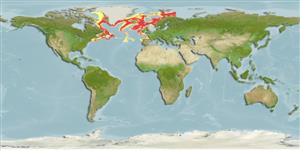Common names from other countries
>
Gadiformes (Cods) >
Gaidropsaridae (Rocklings)
Etymology: Gaidropsarus: Greek, ga, ge = the earth + Greek, ydro = water + Greek psaros = speckled, starling (Ref. 45335).
Environment: milieu / climate zone / depth range / distribution range
Écologie
marin bathydémersal; non migrateur; profondeur 150 - 2260 m (Ref. 58426), usually 400 - ? m (Ref. 9985). Boreal; 76°N - 40°N, 71°W - 31°E
Arctic to North Atlantic: Nunavut, off southeastern coasts of Greenland, all but southern coast of Iceland, the Faroe-Shetland ridge to Norwegian coasts north from Bergen.
Taille / Poids / Âge
Maturity: Lm ? range ? - ? cm
Max length : 35.0 cm SL mâle / non sexé; (Ref. 35388)
Épines dorsales (Total): 0; Épines anales 0
Epibenthic (Ref. 58426). Found offshore in deep water, always on soft bottoms of gravel, sand, mud, shells, and stones. Occurs in water temperatures close to or below 0°C. Feeds on decapod, amphipod, and euphausiid crustaceans, sometimes fishes are included in the diet (Ref. 9985).
Life cycle and mating behavior
Maturité | Reproduction | Frai | Œufs | Fécondité | Larves
Svetovidov, A.N., 1986. Review of the three-bearded rocklings of the genus Gaidropsaurus Rafinesque, 1810 (Gadidae) with description of a new species. J. Ichthyol. 26(1)114-135. (Ref. 9985)
Statut dans la liste rouge de l'IUCN (Ref. 130435)
CITES (Ref. 128078)
Not Evaluated
Menace pour l'homme
Harmless
Utilisations par l'homme
Pêcheries: commercial
Plus d'informations
RéférencesAquacultureProfil d'aquacultureSouchesGénétiqueElectrophoresesHéritabilitéPathologiesTraitementMass conversion
Outils
Articles particuliers
Télécharger en XML
Sources Internet
Estimates based on models
Preferred temperature (Ref.
115969): -0.6 - 9.6, mean 4.1 (based on 279 cells).
Phylogenetic diversity index (Ref.
82804): PD
50 = 0.5001 [Uniqueness, from 0.5 = low to 2.0 = high].
Bayesian length-weight: a=0.00479 (0.00208 - 0.01103), b=3.08 (2.89 - 3.27), in cm Total Length, based on LWR estimates for this (Sub)family-body shape (Ref.
93245).
Niveau trophique (Ref.
69278): 3.4 ±0.3 se; based on diet studies.
Résilience (Ref.
120179): Milieu, temps minimum de doublement de population : 1,4 à 4,4 années (Preliminary K or Fecundity.).
Fishing Vulnerability (Ref.
59153): Low to moderate vulnerability (33 of 100).
